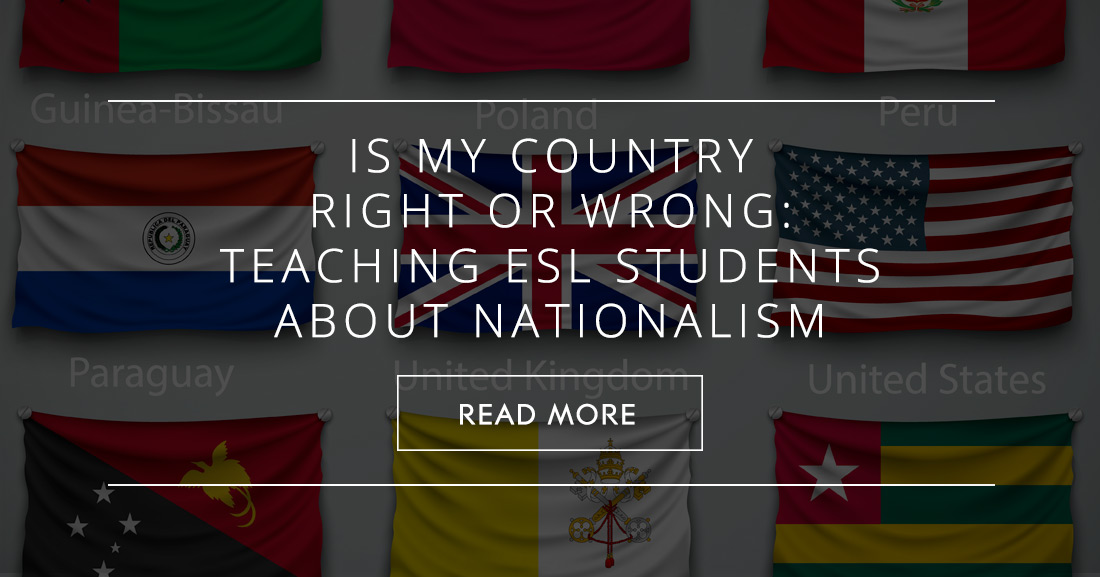My Country, Right or Wrong: 5 Ways of Understanding Nationalism in the ESL Classroom


Far-right parties have come to power, or grown in confidence, in eastern Europe, while the British vote to leave the European Union embodied a strong sense of ‘us and them’, and a renewed determination to prioritize British interests. At the time of writing, one of the 2016 presidential candidates has been repeatedly invoking ‘America First’ policies, so it feels like a good time to help our students understand nationalism and where it comes from.
Before launching into the topic, warm up your students with some questions about the flags of their countries and what they mean. Set up a quick pair-work or interview exercises where students explore these questions:
Elicit this from your students as much as possible. We’re aiming for a clear distinction: a patriot loves their country, but a nationalist favors their country above all others. Give examples of nationalist groups and parties, insignia and policies. A theme of these examples should be (in my personal view) that nationalism has led societies to some very dark places, has caused dangerous and artificial us/them divisions, modifies and distorts history to its own ends, and has inarguably been a root cause of much carnage and despair. Nationalistic fervor has strengths and benefits, also, but these are so often subsumed by the mass of negatives that their justification becomes all but impossible.
Invite your students to imagine a country in which the whole population is fervently nationalist. They carry a deep love of their country, and wish it to succeed, preferably more so than their neighbors. What results might this have?
Your students may well have personal experience of this, but many will not see indoctrination for what it truly is. American parents have no problem with the Pledge of Allegiance (“It develops a positive, patriotic love for the greatest country in the world”), though they might find the exact same practice among Chinese students sinister and threatening (“They’re cynically using nationalism to brainwash and manipulate their children”). Elicit how it is that nationalistic feelings are brought about and strengthened by governments and societies:
Education systems have always been a chief propagator of nationalistic sentiment. Impressionable minds are fed a carefully tailored curriculum of history, sociology and geography, all freighted with a nationalistic message. Past errors are explained away while past insults become magnified; ethnic divisions are highlighted, with ‘scientific’ support brought in to justify them; lines on maps are portrayed as sacrosanct and inviolable, despite centuries of dispute: “This has always been part of our country”.
Changing demographics can create nationalistic pressures. Immigration creates new social pressures and resentment, and there can be a growing sense that a long-cherished culture is being abruptly changed without consultation or consent.
Globalization plays a role also, resulting in lower standards of living in industrialized countries, resentment at jobs being shipped overseas, and a sense that the rest of the world (perhaps, in particular, ‘enemy’ countries) are benefiting while the once-affluent nation suffers a seemingly inexorable decline.
Racism. I would be easily convinced that the vast majority of crowds at nationalistic marches and demonstrations are not multi-ethnic. Race and nationality seem to go hand-in-hand, reinforcing ‘us versus them’ thinking and providing an easy method for identifying the ‘enemy’. There are a tiny number of exceptions to this, but please invite your students to consider the unpardonable fallacy of any group identifying itself as ‘original’ or ‘racially pure’. Examples are easily found, from Hitler’s Germany to Milosevic’s Serbia, and from the Texan ‘minutemen’, to modern, post-Brexit Britain; they are all the purest nonsense.
External Events. I do love the Olympic games, but I confess that it makes me laugh to hear its supporters extolling the games’ ability to ‘bring countries together’ by having them compete against each other! Ask your students whether the medals table is a reinforcement of nationalistic notions, and whether it’s appropriate to celebrate individual countries (especially by playing their anthems during medal ceremonies) during an event designed to foster peace and cohesion. The same question is very relevant to the soccer World Cup, which can produce nationalistic sentiment so strong and violent that diplomatic relations become strained (especially, though not exclusively, in South America).
This is a very fertile area for research and presentation tasks relating to past and present nationalist movements.
If you work with a group of international students, highlight how important it is that they act as worthy ambassadors for their country, and how easily the divisions created by nationalistic sentiment can be broken down through trust and openness.